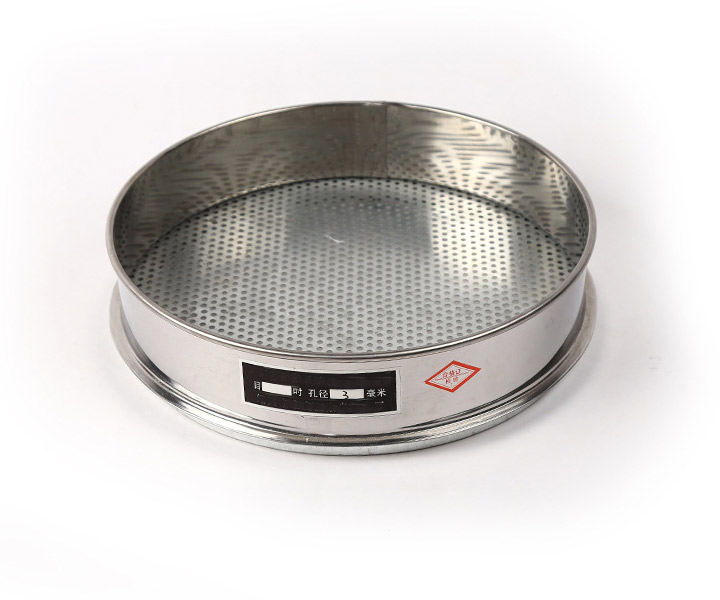
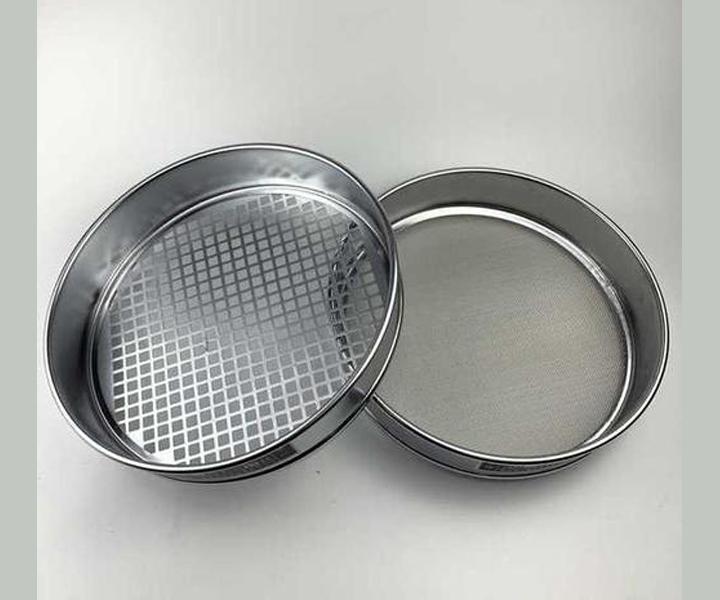
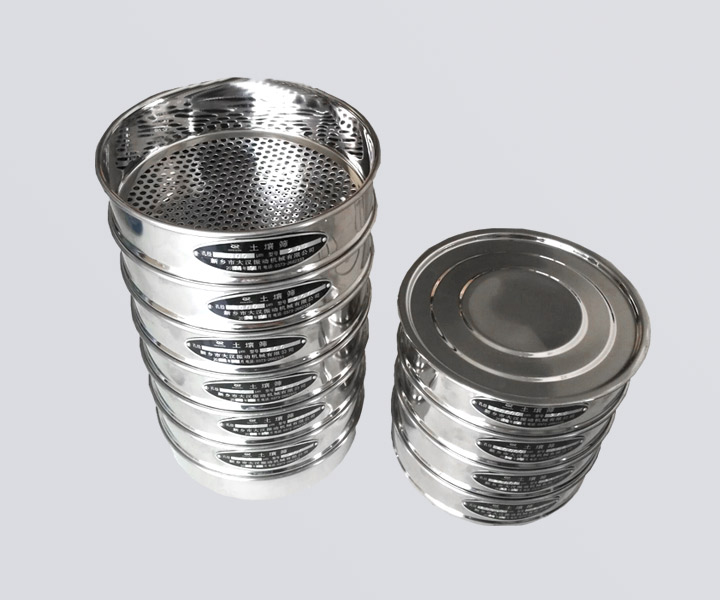
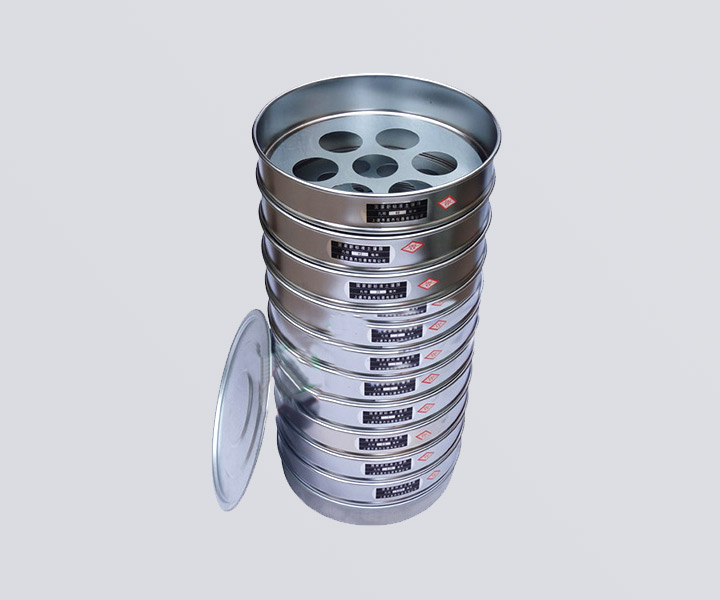
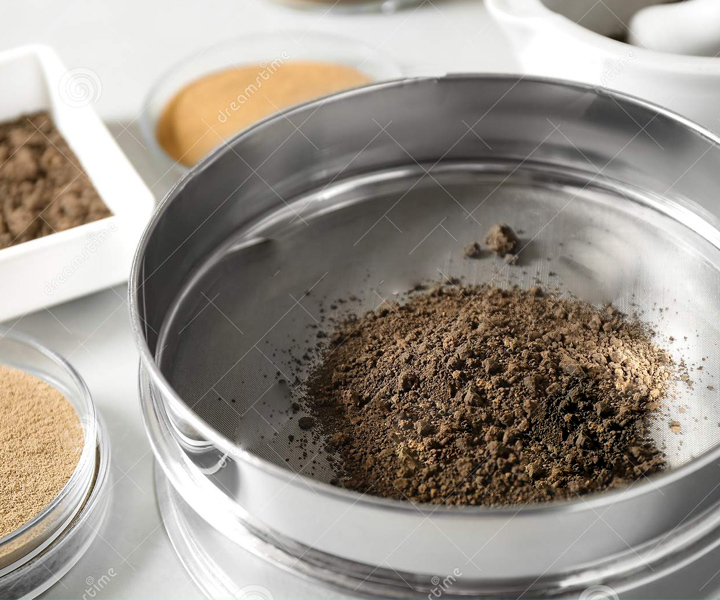
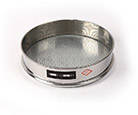

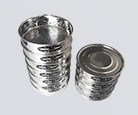
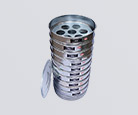

For classifying soil particles into size ranges and quantitatively determining the mass of particles within each range and the determination of fines in soil
![]()
![]()
Price:$20.00 - $200.00/Set
Consult now and enjoy a 10% discount
Sieve diameter: 75mm, 100mm, 200mm, 300mm
Aperture: 0.075mm-60mm (0.075mm-1mm is stainless steel screen, 2mm above is galvanized punching plate)
Number of pieces: 11 sieves plus a set of bottom covers (12 in total), respectively: 0.075mm, 0.1mm, 0.25mm, 0.5mm, 1mm, 2mm, 5mm, 10mm, 20mm, 40mm, 60mm
Hole shape: square hole, round hole, diamond hole
Material: brass, stainless steel, galvanized, etc.
Weight: 5kg
Application:
Standard soil sieves are used to sieve and test various soils, such as soil nitrogen content determination, soil potassium content determination, soil carbonate determination, and can also be used to screen dirt and rocks to form fine bonsai or potting soil, filter Remove the fine dust that can clog the soil mix and remove gravel and other debris.
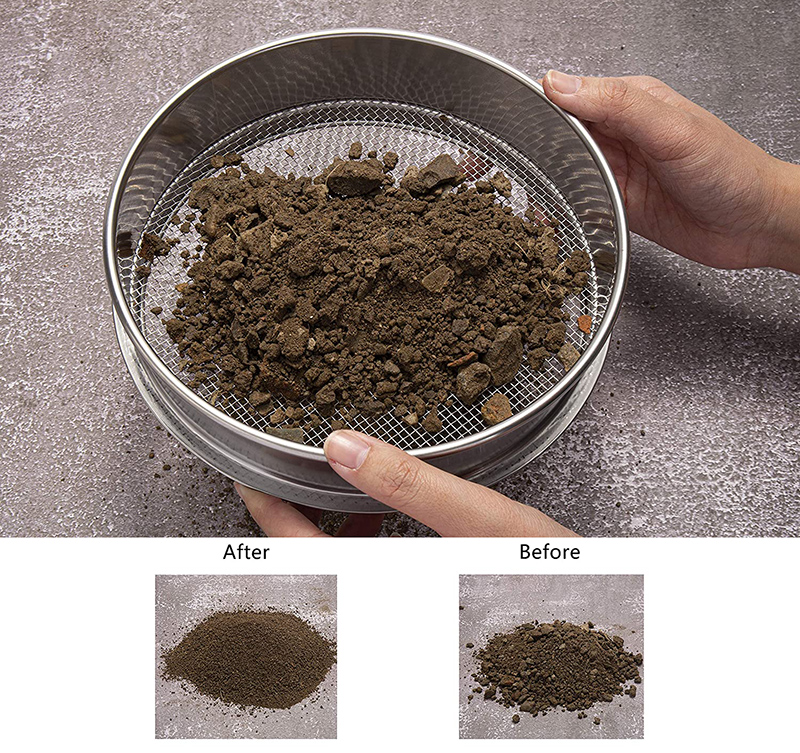
Because of the high water content in the soil, in order to prevent rust, the screen frame and screen are made of 304 stainless steel. Standard soil sieves have a diameter of 75mm, 200mm, and 300mm, and the sieve size is 0.075, 0.1, 0.125, 0.25, 0.5, 0.63, 1, 2, 5, and 10mm.
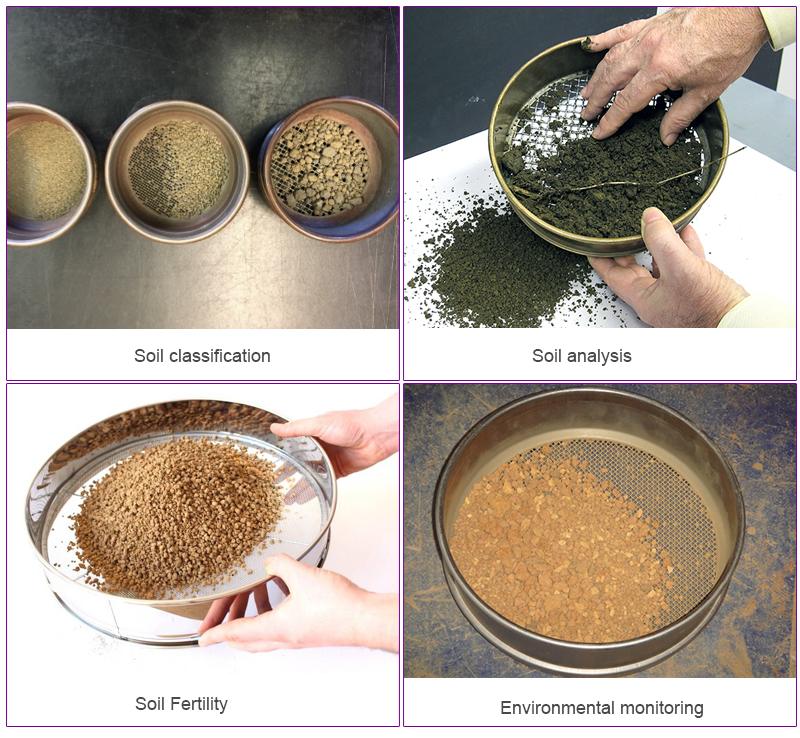
Soil sifters are used for a variety of reasons, including:
1. Soil classification: Sieving is an important step in soil classification, and it is a process of classifying soil according to its physical and chemical properties. Sieving helps determine the particle size distribution of soil, which is a key factor in soil classification.
2. Soil analysis: Sieving is used in soil analysis to determine the soil's texture and structure, which can provide valuable information about its fertility, water-holding capacity, and other properties. Soil analysis is important in agriculture, horticulture and environmental monitoring.
3. Soil Fertility: Sieves are used in soil fertility tests to determine the nutrient content of the soil. By analyzing the particle size distribution of the soil, sieving can help identify any nutrient deficiencies or imbalances in the soil.
4. Construction: Sieving is used in construction to analyze the particle size distribution of soil and other construction materials such as sand and gravel. This information is important in determining the suitability of a material for a particular construction application.
5. Environmental monitoring: Screening is used for environmental monitoring, analyzing the particle size distribution of soil and sediment, which can provide valuable information about environmental factors such as soil erosion and pollution.
Overall, soil sieves are an important tool for soil analysis, classification and monitoring. By providing accurate and reliable particle size analysis, soil sieves can help improve soil fertility, identify potential environmental hazards, and ensure soil and other building materials are suitable for specific applications.
| Common names of soils (General texture) | Sand | Silt | Clay | Textural class |
| Sandy soils (Coarse texture) | 86-100 | 0-14 | 0-10 | Sand |
| 70-86 | 0-30 | 0-15 | Loamy sand | |
| Loamy soils (Moderately coarse texture) | 50-70 | 0-50 | 0-20 | Sandy loam |
| Loamy soils (Medium texture) | 23-52 | 28-50 | 7-27 | Loam |
| 20-50 | 74-88 | 0-27 | Silty loam | |
| 0-20 | 88-100 | 0-12 | Silt | |
| Loamy soils (Moderately fine texture) | 20-45 | 15-52 | 27-40 | Clay loam |
| 45-80 | 0-28 | 20-35 | Sandy clay loam | |
| 0-20 | 40-73 | 27-40 | Silty clay loam | |
| Clayey soils (Fine texture) | 45-65 | 0-20 | 35-55 | Sandy clay |
| 0-20 | 40-60 | 40-60 | Silty clay | |
| 0-45 | 0-40 | 40-100 | Clay |
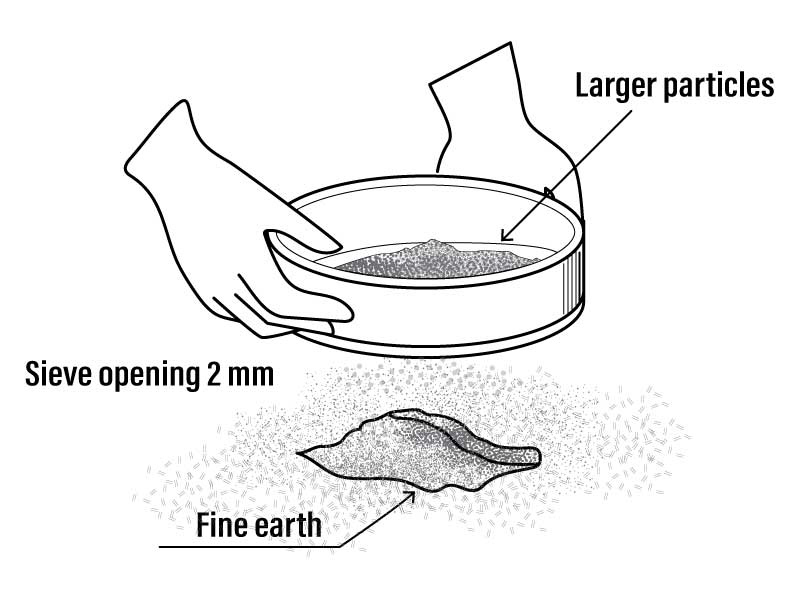
Standard soil sieves is suitable for the analysis of soil with a particle size greater than 0.074mm, and can separate soils of different finenesses. The particle size distribution of the soil can be determined through the soil sieves classification experiment. It is suitable for the determination of soil nitrogen content, soil potassium content, and soil carbonate. Determination, can also be used to sieve soil and rocks to form fine bonsai or potting soil, filter to remove fine dust that will clog the soil mixture and remove gravel and other debris, it is a necessary sieving instrument for soil experiments.

Soil sieve separates the soil particles into different particle sizes through the screen. The soil is put into the sieve, and through mechanical vibration or manual stirring, the particles are vibrated, smaller particles pass through the sieve, and larger particles are filtered out. The pore size of the screen determines the size of the separated particles, and the vibration force makes the particles jump on the screen to promote separation. Different screen apertures can achieve different grading effects, remove impurities and improve soil quality.
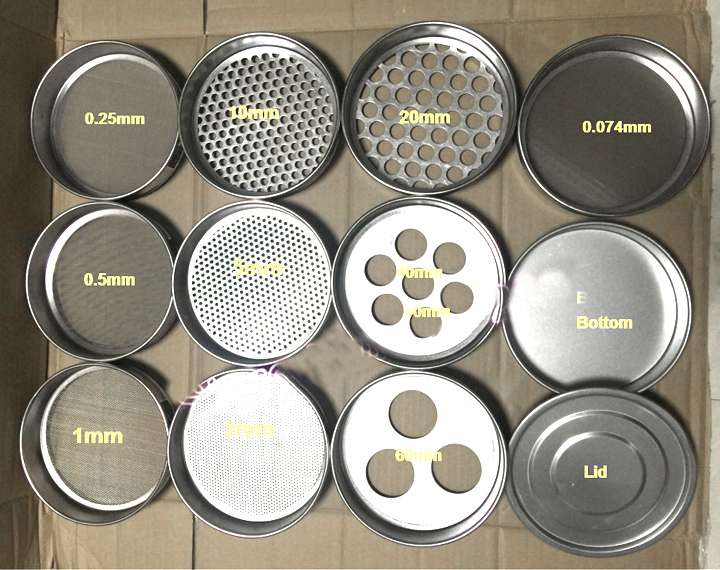
Soil sieve specifications: φ200*50, φ300*60, φ400*65.
Soil sieve aperture: 0.074mm, 0.25mm, 0.5mm, 1mm, 2mm, 5mm, 10mm, 20mm, 40mm, 60mm.
Note: 1mm can sieve dust powder in soil, 3mm can sieve 1-3mm soil particles, 6mm can sieve 6mm medium soil particles.
| Dia.(mm) | Height(mm) | Frame | Bottom | Hole | Opening Size |
| 300 | 50 | Iron | Stainless Steel | Square / Round | Random |
| 300 | 50 | Stainless Steel | Stainless Steel | Square / Round | Random |
| Dia.(mm) | Height(mm) | Frame | Bottom | Hole | Opening Siz |
| 200 | 50 | Iron | Stainless Steel | Square / Round | Random |
| 200 | 50 | Stainless Steel | Stainless Steel | Square / Round | Random |
| 200 | 50 | Brass | Brass | Square / Round | ≤4mm |
| 200 | 50 | Brass | Stainless Steel | Square / Round | Random |
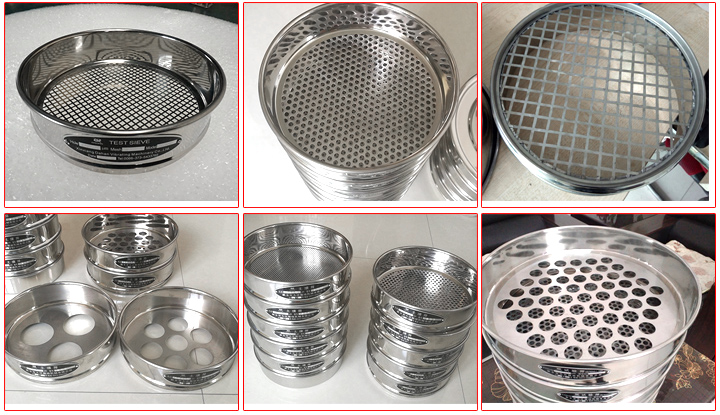
| NO. | Type | Specifications |
| 1 | New standard sand sieve (φ300,7 pieces/set + bottom cover) | 9.50、4.75、2.36、1.18、600um、300um、150um |
| 2 | New standard stone screen (φ300 12 pieces/set + bottom cover) | 2.36、4.75、9.50、16.0、19.0、26.5、31.5、37.5、53.0、63.0、0.75、90.0mm |
| 3 | Road base aggregate screen (φ200, 300,11 / set + bottom cover) | 0.075、0.25、0.5、1、2、5、10、20、30、40、50mm |
| 4 | Drain the aggregate square sieve | 0.075、0.15、0.3、0.6、1.18、2.36、4.75、9.5、13.2、16、19、26.5、31.5、53mm |
| 5 | New standard square hole sieve (Φ200 ×50mm6 pieces/set) | Iron square hole:4.75、9.5、13.2、16、19、26.5、31.5、37.5、53mm Wire mesh square hole:0.075、0.15、0.3、0.6、1.18、2.36 |
| 6 | Blanking frame type sand screen (casting screen) φ200 (11 pieces/set) | 3.35、1.7、0.85、0.6、0.425、0.3、0.212、0.15、0.106、0.075、0.53mm |
| 7 | Pavement square hole aggregate screen | 80、60、50、40、30、25、20、10、5、2、1、0.5、0.2、0.075mm |
| 8 | Asphalt pavement aggregate screen (φ200, 300, 15 / set + bottom cover) | 0.075、0.15、0.3、0.6、1.18、2.36、4.75、9.5、13.2、16.0、19.0、26.5、31.5、37.5、53mm |
| 9 | Sand sieve Φ200 ×50(8 pieces/set) | Square hole copper mesh:2.5、1.25、0.63、0.315、0.16、0.08mm |
| 10 | Stone sieve Φ300 ×70mm (12 pieces/set) | 2.5、5、10、16、20、25、31.5、40、50、63、80、100mm |
| 11 | Lime screen (φ200 5 pieces/set + bottom cover) | 0.125、0.71、0.9、5、20mm |
| 12 | New standard pharmacopoeia sieve Φ 200×50mm (9 pieces/set) | 2、0.85、0.355、0.25、0.18、0.15、0.125、0.09、0、075mm |
Accurate Particle Size Analysis
Provides accurate and reliable particle size analysis of soil samples. By dividing soil particles into fractions of different sizes, sieving can help determine the texture and structure of soil, which can provide valuable information about its fertility, water-holding capacity, and other properties.
Versatility
Versatile, they can be used in a wide range of applications including soil analysis, construction and environmental monitoring. By providing accurate particle size analysis, soil sieves can help improve soil fertility, identify potential environmental hazards, and ensure soil and other building materials are suitable for specific applications.
Consistent results
Provides consistent results, which is important in soil analysis and classification. By using standardized particle size analysis methods, soil sieving can help ensure consistent and reproducible results.
Cost-effectiveness
Soil sieves are relatively inexpensive compared to other soil analysis equipment, making them a cost-effective tool for soil analysis and classification, especially for small-scale or field applications.
Easy to use
Easy to use with minimal training required. These sieves are designed to be simple and intuitive, making them easy to use for a wide range of users.
Durability
The screen frame is made of SUS304 stainless steel stretched and polished, with a wall thickness of 0.6mm, uniform luster, strong and durable, and non-magnetic.
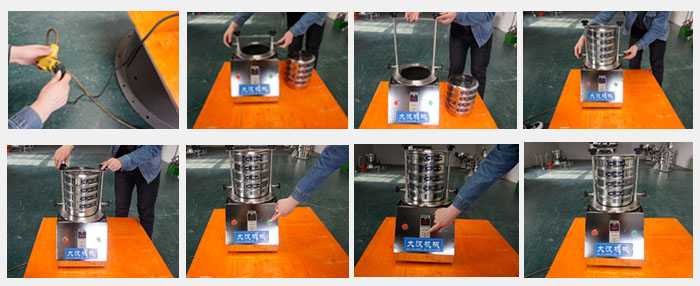
1. Take soil from air-dried loose soil samples by quartering. The quantity of soil is carried out according to the following figure in the table.
2. The sample was screened by 2mm, and the soil quality on and under the screen was respectively weighed out. Pour the soil on the 2mm screen into the upper layer of the coarse screen stacked in turn, and pour the soil under the 2mm screen into the upper layer of the fine screen stacked in turn (analysis screen from top to bottom aperture large to small stack). The sieve shaker is used to fully sieve out until the soil particle diameter on each sieve is greater than the mesh pore diameter, generally shaking the sieve for 15~30min;
3. Starting from large aperture sieve, each sieve will be removed in sequence, and the soil left on each sieve will be weighed respectively, accurate to 0.1g. The difference between the sum of the soil mass on each screen and the total soil mass shall not be greater than l% of the total soil mass.
4. Calculate the content of grain group and cumulative content, draw the gradation curve, get the characteristic particle size, analyze the gradation of soil, and name it according to the specification.
| Soil particle size (mm) | <2mm | <10mm | <20mm | <40mm | >40mm |
| Sampling mass (g) | 100-300g | 300-900g | 1000-2000g | 2000-4000g | Above 4000g |
1. Coarse sieves commonly used in standard soil sieves are generally round holes with apertures of 100, 80, 60, 40, 20, 10, 5, 2mm; fine sieves are generally square holes with equivalent apertures of 2.0, 1.0, 0.5, 0.25, 0.10, 0.075mm. There are some differences in the pore size classification of analytical sieves used in different countries and departments;
2. Analytical balance, analytical balance needs two types according to the weighing range and accuracy: (1) weighing 10kg, with a sense of 1g, (2) weighing 1000g, with a sense of 0.1g;
3. Shaker, the specification stipulates that the shaker can shake in the horizontal direction and slap in the vertical direction. The shaking frequency is 100~200 times/min, and the slapping frequency is 50~70 times/min.
| Soil Project | Standard | Test Sieve Requirements | Calibration Result |
| Moisture | Gravimetric method for determination of soil dry matter and moisture | Aperture 2mm | 2.0mm |
| HJ 613-2011 | |||
| Organic Carbon | Determination of Soil Organic Carbon | Aperture 2mm | 1.93mm |
| Potassium Dichromate Oxidation - Spectrophotometry | Aperture 0.25mm | 0.262mm | |
| HJ 615-2011 | |||
| Chromium | Determination of total chromium in upper soil | Aperture 0.149mm | 0.153mm |
| flame atomic absorption spectrophotometry | |||
| H491-2009 | |||
| Copper | Determination of Soil Quality Copper and Zinc by Flame Atomic Absorption Spectrophotometry | Aperture 2mm | 2.07mm |
| Zinc | GE/T 17138-199T | Aperture 0.149mm | 0.153mm |
| Lead | Determination of the quality of soil and pots Graphite furnace atomic absorption spectrophotometry GB/T 17141-1997 | Aperture 2mm | 2.0mm |
| Determination of lead and cadmium in soil quality KI-MIBK extraction | |||
| Cadmium | Flame Atomic Absorption Spectrophotometry B/T 17141-1997 | Aperture 0.149mm | 0.153mm |
Add handles or grips to the frame for easier handling.
Consider painting or waterproofing the frame for durability.
Place the sieve over a container or bin to collect sifted soil.
Pour soil onto the sieve and gently shake or agitate it to allow fine particles to pass through the mesh.
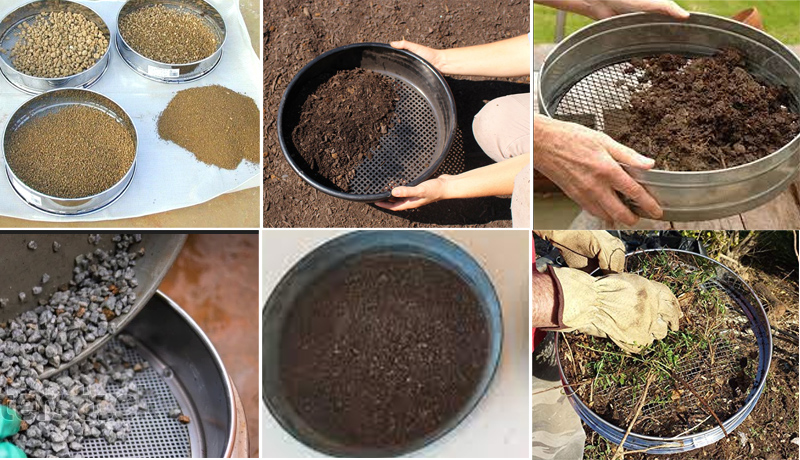
How soil sieves are used in different industries:
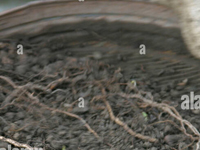
Agricultural Research
A research facility uses soil sieves to analyze soil samples from different regions to determine their nutrient content and suitability for growing specific crops. Soil sieving helps provide accurate particle size analysis and identifies any soil health issues that may affect crop growth.
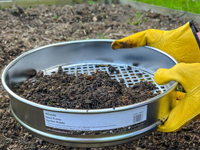
Soil Remediation
An environmental consulting firm uses a soil sieve to analyze soil samples from a contaminated site to determine the particle size distribution and composition of the soil. Soil sieving helps determine the presence of heavy metals and other contaminants, which informs remediation strategies.
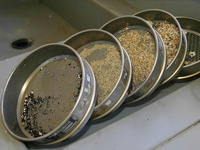
Building Material Analysis
A construction company uses soil sieves to analyze sand samples from a quarry to determine particle size distribution and suitability for concrete production. Soil sifters help determine the proper sand size for a specific project and ensure the quality of building materials.
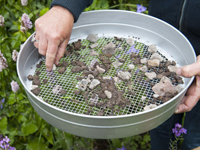
Gardening
Greenhouses use soil sieves to analyze soil samples from different pots to determine nutrient content and suitability for growing specific plants. Soil sieving helps provide accurate particle size analysis and identifies any soil health issues that may be affecting plant growth.
Department of Agriculture Soil Texture Grade (If you need a more accurate definition of your soil's texture grade, you should take a disturbed soil sample to a testing lab to quantify particle size.):
| Common name of soil (general texture) |
Sand | Sludge | Clay | Texture |
| Sandy soil (coarse texture) |
86-100 | 0-14 | 0-10 | Sand |
| 70-86 | 0-30 | 0-15 | Fertile sand | |
| Loam (moderately rough texture) |
50-70 | 0-50 | 0-20 | Sandy loam |
| Loam (medium texture) |
23-52 | 28-50 | 7-27 | Loam |
| 20-50 | 74-88 | 0-27 | Silty Loam | |
| 0-20 | 88-100 | 0-12 | Silt | |
| Loam (moderate texture) |
20-45 | 15-52 | 27-40 | Clay loam |
| 45-80 | 0-28 | 20-35 | Sandy clay loam | |
| 0-20 | 40-73 | 27-40 | Silty Clay Loam | |
| Clay (fine texture) |
45-65 | 0-20 | 35-55 | Sandy clay |
| 0-20 | 40-60 | 40-60 | Silty clay |
Address:China,Yanjin county forest park gate to the west 1000 meters north road.